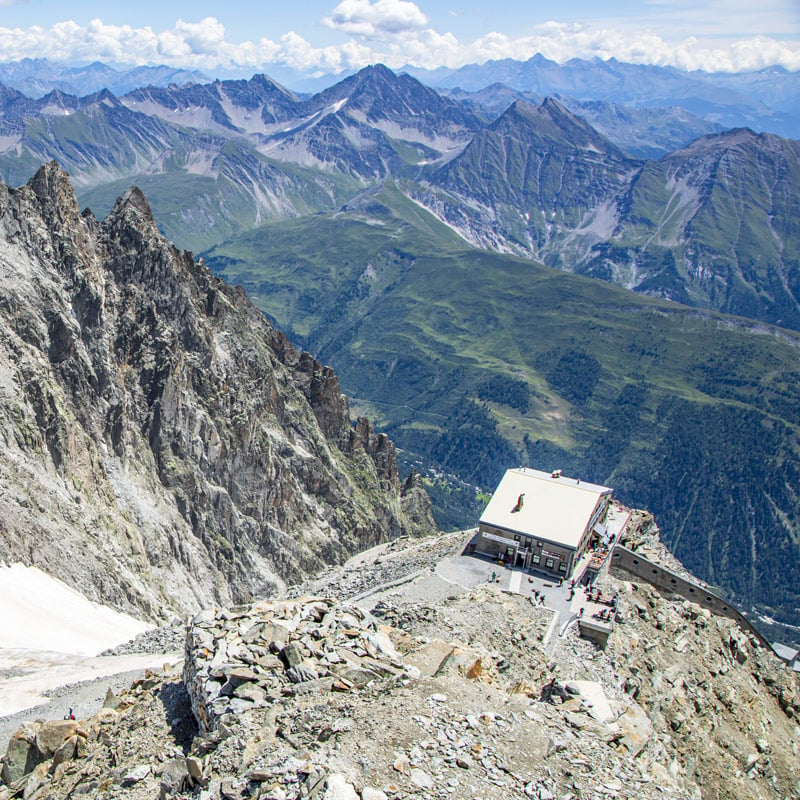
AN EAGLE’S NEST ON THE MOST FAMOUS GRANITE IN THE WORLD
His gaze is focused on the mountains, even while he’s chatting. Armando can’t tear his eyes away from the window, from the blinding white of the glacier. Rifugio Torino is incredibly silent today. The climbers have already left, and the tourists haven’t arrived yet. An uneasy calm. “Excuse me,” Armando murmurs, bringing his thoughts back to the moment. With his binoculars he inspects the mountain, the highest in the Alps, Mont Blanc, which from the Italian side appears imposing and difficult. A dream made of ice and granite, where everyone can choose their own playground, where everyone can express their own style of mountaineering.
Today there’s a special light here, at 3,000 meters. It’s the first sunny day after many with bad weather. The walls are still covered in snow, and there are few climbers, but someone is already moving. “Matteo Della Bordella passed by a few days ago,” comments our host. Armando Chanoine has been spending his summers in the most famous eagle’s nest in the Alps for 10 years. It offers rest and refreshment to those fleeing the hustle and bustle, to disoriented tourists, and to mountaineers returning tired from pursuing their dreams. He watches over them like a father, and until they’re all back at the rifugio, his thoughts are fixed on that strange, still world outside the window. “Horrible weather. They haven’t managed to do anything,” he adds while scanning the routes with his binoculars in search of colored ants. They are the climbers who spent the night here before going out to give free rein to their art, tracing imaginary lines on the most famous granite in the world.
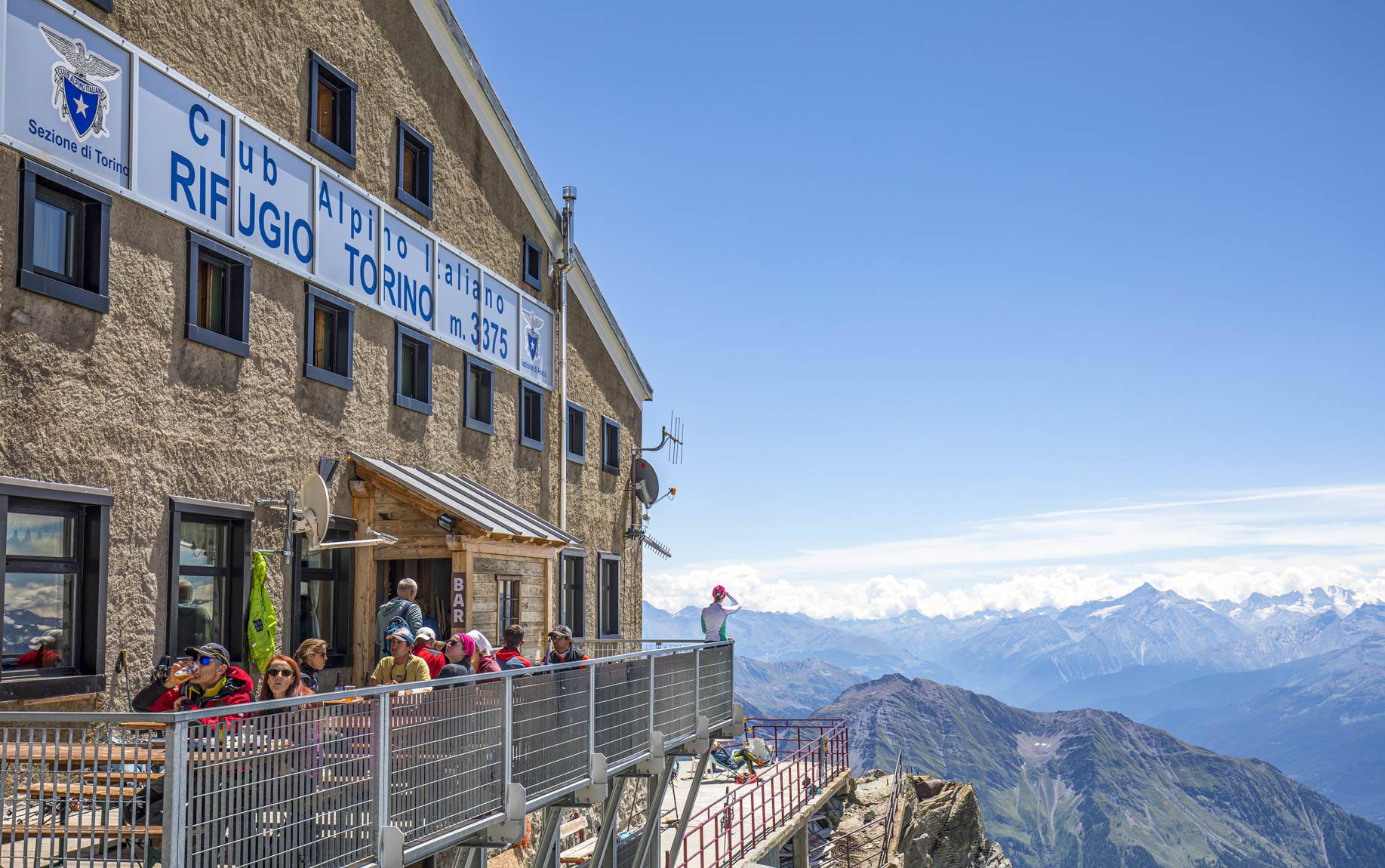
Rifugio Torino is immersed in an otherworldly silence that’s broken only by the background noise of the refrigerators. There are just a few hours of respite, time spent cleaning up the building and preparing for a new day of hospitality. “We’re a well-oiled machine,” Armando jokes. It was Christmas 2012 when he decided to take over management of the rifugio together with his family. “Today I manage both Rifugio Torino and Rifugio Monzino, but it’s thanks entirely to my family. They were the ones who convinced me when I was offered the rifugio. I didn’t want to. I was afraid I wouldn’t be able to do it ... but in the end, here we are.” His gnarled hands strike the table together, a gentle thump on the smooth, polished wood.
Built in the early 1950s by the Turin and Aosta chapters of the Club Alpino Italiano, this eagle’s nest facing Mont Blanc quickly became a mecca for mountaineers and hikers. Some of the most classic climbs to the peaks of the Mont Blanc massif start from here, such as the Dente del Gigante, Mont Blanc du Tacul, and Tour Ronde, as well as the Grand Capucin and Aiguille de Toula. In short, whether you’re a beginner or an expert mountaineer, you have to pass by Torino — if only to enjoy the magnificent panoramas offered by this place on the border between the human and the imaginary. Looking west, the view is filled by a huge sea of ice from which vertical rocky pinnacles emerge, dominated by the imposing beauty of the 4,810 meters of Mont Blanc.
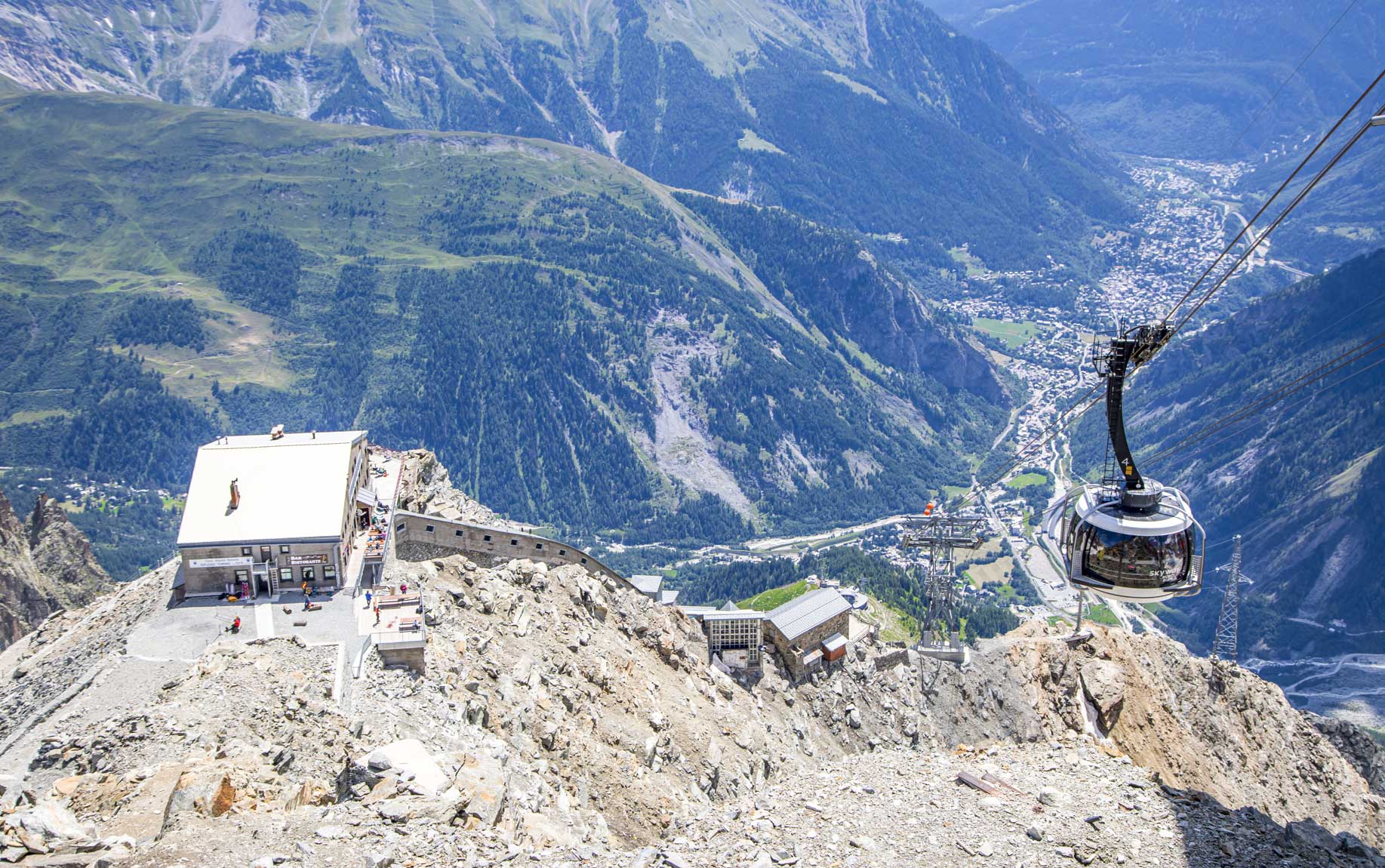
Reaching it is more than easy today, thanks to the Skyway, but things were once very different. Before the famous Mont Blanc cable car was inaugurated, going up to Rifugio Torino was a feat for the few. It was necessary to follow a path, which still exists, starting from Rifugio Pavillon. A long and complex mountaineering-style road that’s now little traveled, especially by climbers who prefer to arrive at the Torino rested and then focus on their mountaineering goals. “The four years when they were building the Skyway were very hard,” recalls Armando, who initially arrived here at the rifugio’s 3,375 meters to support the construction of the cable car. A structure was needed that could welcome and accommodate the workers during the period of the construction project. His presence, between 2011 and 2015, was critically important in ensuring support for the massive construction site.
“A hot meal and a roof over your head, when you’re working in extreme environmental conditions, are worth their weight in gold,” he says. The major difficulties Armando encountered included the immediate need to provide an adequate level of hospitality: “Right from the start, we had to equip ourselves to work even in winter, with temperatures that can reach 20 or 30 degrees below zero.” Then, in 2015, after the inauguration of the cable car, major modernization work gave the rifugio its current appearance.
With the Skyway, the rifugio changed. “From 2012 to today, we’ve seen a constant increase in visitors. We are an international destination. Many people come up to admire the eighth wonder of the world,” Armando says. He knows very well the value of the Torino’s numbers. At Monzino, the other rifugio he manages, the number of visitors is quite different: “I would say less than one-tenth.” Normal, one might say. We’re at the foot of the Freney glacier, and to reach the structure you have to embark on a long walk that requires both fitness and sure footing. Accessibility increases visits. And then you add the sight of the southern face of Mont Blanc. “Beautiful to look at and varied to climb. Starting from the rifugio you can make many different ascents, with something for everyone — both easy and difficult,” he explains. Among the easiest and most famous climbs is certainly the Dente del Gigante, where climbers can start testing the high-elevation rock. A test, if desired, for something that could be more demanding, like the Matterhorn. But the Mont Blanc massif also offers challenging climbs, on historic routes, such as those that run along the vertical lines of the Gran Capucin, a true mountaineering icon. And also the Tour Ronde and Mont Blanc du Tacul. In short, a rich buffet from which you can freely choose your favorite dish.
Experiencing summers as a Mont Blanc rifugio manager is a privilege but also a significant commitment. Not only because of the difficulties involved in offering quality hospitality at a challenging elevation, but above all for the key role of safeguarding the mountain terrain that characterizes a rifugio. Everyone goes to the Torino sooner or later. Ueli Steck stopped for a coffee in 2015, on his way to climbing all 82 of the 4,000-meter Alpine peaks in just 80 days. By now, Matteo Della Bordella, with his comrades from the SMAM (High Mountain Military Section), is at home here. And also other great names in Italian and international mountaineering, who, animated by the same sentiment, meet in this place of mixing and sharing. The same sentiment that drives the hundreds of enthusiasts who flock to the rifugio every day in search of dreams to achieve. Armando and his family will welcome them when they open the door, advise them on the conditions of the routes, and pamper them when they return from their adventures. His experience as a mountain guide is essential here: “The rifugio manager must above all be a guide, or at least have extensive experience in the mountains. He must be a practitioner. I spend entire days on the phone, giving out advice and information on the conditions of the routes and the most suitable equipment. This is also part of the job — a critical part.” A completely different approach from what happens when booking a hotel in a city. The dimension of the rifugio is in a class of its own, a reality that’s often difficult to communicate. The rifugio is a cultural stronghold, a place of culture and environmental protection. Rifugio managers are the first caretakers of the mountains and, in the end, everything stems from a deep passion. “I’ve always had an intense bond with this world — not only with the world of mountaineering but with the mountains in general,” Armando tells us. “Above a thousand meters, you live a different life. I grew up making hay and cleaning up the woods and trails, and then I developed a passion for the vertical world.”
“When I only had Monzino,” he continues, “I was also able to carve out time for my own climbing, but a bit less today. I get the same joy from observing the eyes of those returning from their climbs. You see them, glistening from the wind and cold, full of emotion. Satisfied.” But it isn’t always like this. “Accidents happen, every year. I often tell myself that you have to get used to it, but every time it’s difficult. They all pass through here. They go up full of energy, you have fun together, you learn about their dreams … then someone doesn’t come back.” These are the hardest moments, the ones you never get used to. And there’s no one at fault or guilty. It’s part of the mountain game. It’s part of taking controlled risks to pursue an overwhelming passion and feel alive.
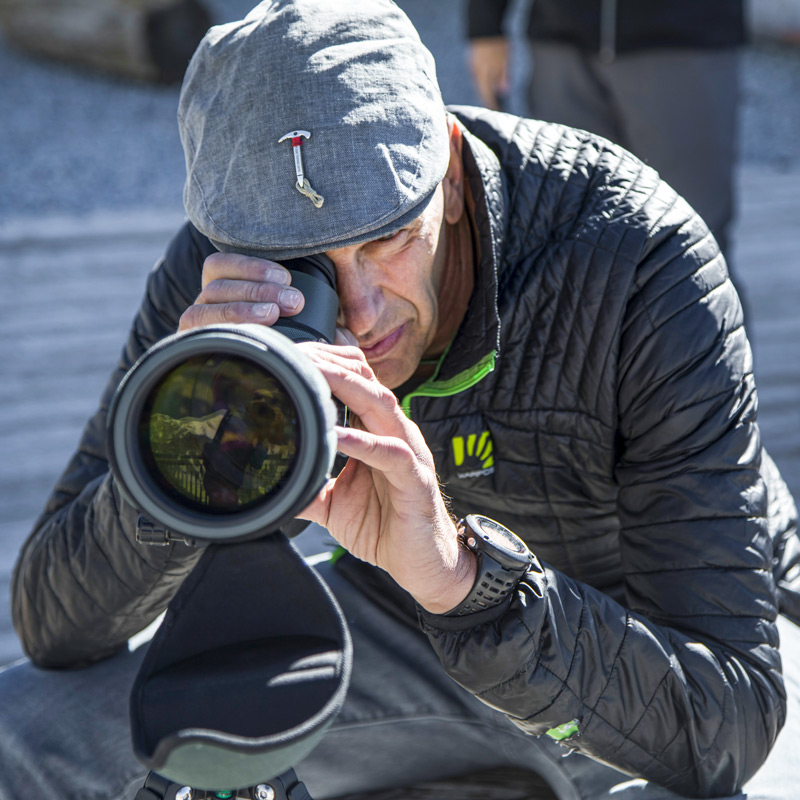
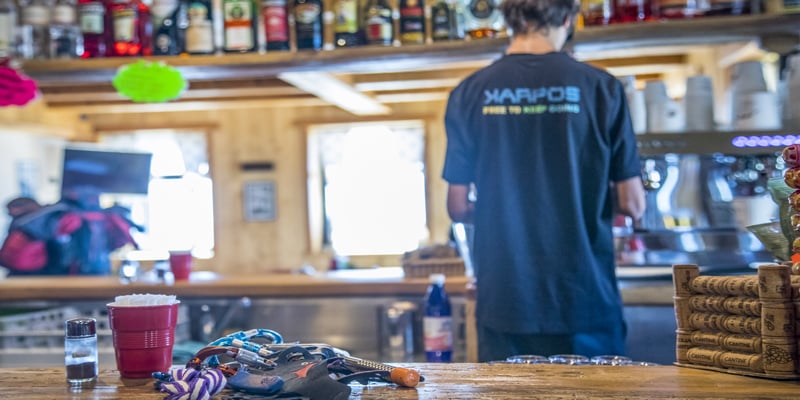
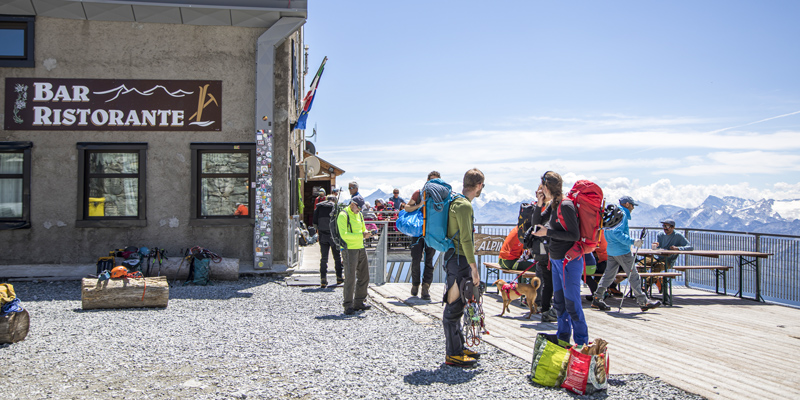
A LONG-AGO ASCENT BY MANRICO DELL’AGNOLA
Those were different times. I don’t know if the glacier was very different or if it was just our concept of safety that was the problem, but the fact is that we tackled the Gran Capucin that time as if it were a normal climb in the Dolomites.
Starting from Feltre, where the stars were still shining in the dark sky, we quickly crossed northern Italy, heading west, like in an American dream. We wanted to take the first cable car up. We knew that up there, great red walls towered over enormous glaciers, but this neither impressed nor discouraged us; we were looking for rock, and Gran Capucin was made of rock, so we asked no questions. To us, the glacier was nothing but snow, and getting our old tennis shoes wet was no problem at all. My climbing partner, Andrea, out of an excess of caution, took a very old pair of leather hiking boots from his backpack. He said that in case of an emergency we could each wear one. We simply walked on the snow on the glacier, having covered our shoes with plastic bags to make them waterproof, and the idea of roping up never entered our minds.
We took out the old boots only to get over the crevasse at the head of the glacier, which was quite deep — certainly deeper than we imagined. Then the climb went very well; on rock, we felt at home. A series of beautiful pitches up fantastic and, all in all, not too difficult rock took us to the top. We had thought ahead: in the backpack we’d put two down sleeping bags that we would need to spend the night on the wall, on the glacier, or, in the most optimistic scenario, near the rifugio.
We were almost at the top when Andrea made a wrong move and dropped the backpack, and all our hopes of sleeping fell down the wall. It was late, and in an instant we felt trapped. Getting angry wouldn’t have helped; the important thing at that point was to get ourselves down the wall and to the rifugio. We’d already understood that in those conditions, a bivouac in our fleeces would have been, if not fatal, certainly very difficult. We descended, zigzagging on the unfamiliar face, with a series of rappels and some nerve-wracking fixed ropes. It was already dark, and we were quite desperate, also because in addition to the sleeping bags, the camera and our wallets were in the backpack as well. We completed the descent by moonlight. It was certainly not the time to try to recover the backpack, which had no doubt slipped into the crevasse somewhere. We had to try to reach the rifugio; it was our only hope. We’d been up for almost two days, we weren’t acclimated, and it was starting to get very cold. On the glacier, Andrea started to rave: he collapsed in the snow, he wanted to sleep there, he was exhausted. I was wrecked too, but, remembering those stories by Buhl and Bonatti where in certain conditions everyone fell asleep and died, I kicked my friend’s butt trying to get him up again.
We reached Rifugio Torino after midnight. I remember that we banged on the door and a man opened it for us. As soon as he saw us, his expression changed. He understood and immediately offered us hot tea, gave us some blankets, and let us sleep somewhere — I don’t remember where. It was a summer in the early 1980s, we’d climbed the Bonatti route on the Capucin, and that rifugio saved our lives.